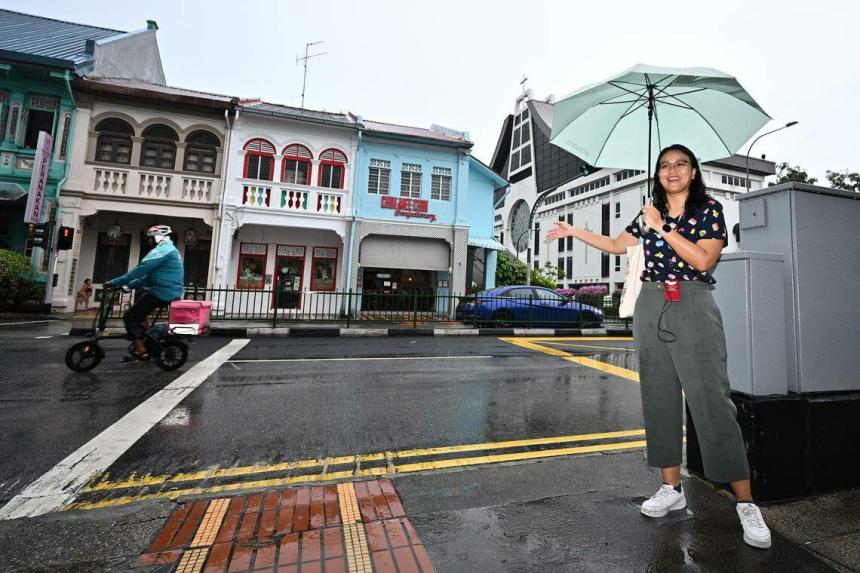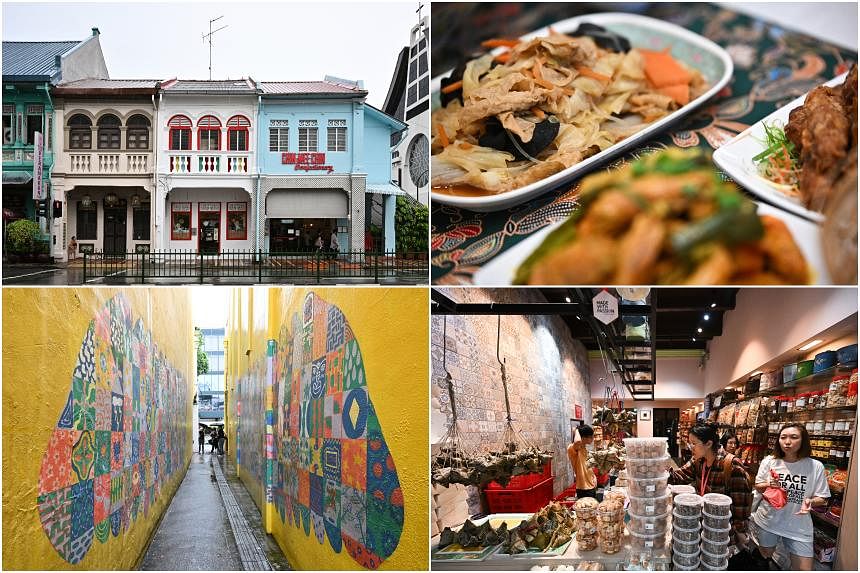SINGAPORE – Ms Tan Li Ming, 35, has lived her whole life in the Katong-Joo Chiat neighbourhood, an area commonly associated with Peranakan culture and heritage.
While she was always curious about the history that surrounded her, it was not until the avid traveller was exposed to the many different cultures of the countries she had visited that she developed a strong desire to learn and tell others about the neighbourhood she grew up in.
The Covid-19 pandemic presented an opportunity.
Ms Tan, an associate scientist who analyses satellite images at the National University of Singapore, created an Instagram account (@katong.joochiat) to showcase the neighbourhood’s businesses and draw customers to them amid bans on dining in.
But she wanted to do more. So she responded to an open call by the National Heritage Board (NHB) for volunteers to get involved in the board’s new Heritage Activation Nodes initiative, which seeks to involve community partners in celebrating the heritage of Singapore’s neighbourhoods.
Come April 20, Ms Tan will be among 122 volunteers helping to run a two-day festival comprising 29 programmes that will mark the launch of the first node, which will be at Katong-Joo Chiat.
Another node will be launched in Clementi later in 2024. NHB is in the process of identifying the remaining two nodes to be established in 2025.
Each node will showcase a neighbourhood’s heritage through three avenues: spaces, such as heritage markers and pop-up installations; programmes, such as guided trails and workshops; and Heritage Champions, which include volunteers such as Ms Tan who will organise and execute community-driven programmes.

Mr Alvin Tan, NHB’s deputy chief executive for policy and community, said that through the nodes, the board hopes to grow its network of community partners islandwide and encourage community ownership of heritage initiatives.
To that end, a public call for collaboration project ideas for Katong-Joo Chiat will be held alongside the launch of the neighbourhood’s node on April 20.
Such collaborations could include exhibitions, talks, murals and artwork installations, and will be assessed for NHB funding of up to $6,000 per project based on factors such as the project’s ability to present the neighbourhood’s heritage to new audiences, and through innovative means.
Mr Tan said that up to five projects will be funded under the first public call, with subsequent calls for collaboration to be launched, should there be strong public interest in initiating projects.

One of the highlights of the two-day festival is an intercultural food programme by ground-up initiative SayurStory and Nonya dumpling store Kim Choo Kueh Chang, which explores the similarities and differences between Nonya dumplings and arem-arem, an Indonesian rice cake normally wrapped in banana leaves.
Referencing SayurStory’s goal to build ties between Singaporeans and migrant domestic workers, Kim Choo Kueh Chang director Edmond Wong, 41, noted that Singapore has always largely comprised a migrant society.
He said that using leaves to cook is a common concept in this region, although various types are used: banana, bamboo and pandan.
“Although the ingredients may be different, rather than focus on the differences, I think the better position to take is to explore the cultural common ground and the similarities we share as South-east Asians,” he said.
Festivalgoers can also look forward to a dance performance by the Peranakan Indian (Chitty Melaka) Association of Singapore that features a blend of Malay, Chinese and Indian dance traditions, as well as tours and games, and Tok Panjang, the festival’s finale event that includes a Peranakan feast, community performances and dancing.

Mr Tan said neighbourhoods selected by NHB to be heritage activation nodes generally meet several criteria, such as the presence of suitable and accessible spaces for heritage programmes and, most importantly, whether there are community groups to partner the board and spearhead programmes.
Neighbourhoods in which NHB does not have a presence – through its museums or institutions – are also prioritised.
For the Katong-Joo Chiat node, Katong Culture – an interest group established by the Joo Chiat Community Club Management Committee in January 2023 – was selected as NHB’s anchor partner.
Founder Gavin Chan, 39, said the group’s work has been boosted with NHB’s support, particularly in developing volunteers’ skills through workshops, such as programmes on tour guiding that Ms Tan attended, as well as increasing the group’s pool of volunteers beyond Katong-Joo Chiat residents.
“The culture and history of Katong-Joo Chiat transcend geographical boundaries. It is of shared interest to the whole of Singapore because the area represents a culture you don’t necessarily find elsewhere,” said Mr Chan.
About two-thirds of the 122 volunteers who will help out at the launch festival are not residents of the area, he said.

Mr Tan said 15 briefing and training sessions have been conducted since December 2023 to prepare volunteers for their involvement in the heritage nodes.
Beyond the festival, Mr Chan said, Katong Culture is looking to stage more community art creation programmes, as well as document more of the area’s sites and culture.
Mr Tan said NHB’s support for the node in Katong-Joo Chiat, and the other nodes to be launched, will last till 2027, when the board’s ongoing five-year Our SG Heritage Plan 2.0 ends.
Further support will depend on the outcomes of engagement with community partners then, he added.
Mr Wong said the neighbourhood’s community groups and businesses like Kim Choo Kueh Chang have “gotong royong (communal help)”, and “we all put in our own efforts to make Katong-Joo Chiat a vibrant place”.

Recalling that Joo Chiat was in 2011 named Singapore’s first Heritage Town by NHB – which came with $100,000 to develop heritage activities – Mr Wong said old and new initiatives such as the heritage activation nodes “give us this understanding that we are not doing this by ourselves”.
“We have support from various government agencies, and various stakeholders will see this and want to be involved,” he added.
“The Heritage Activation Node platform is like a lighthouse. It gives us a channel to showcase our abilities, and calls out to others to join us on this journey.”
A full list of the programmes under the launch festival can be found at go.gov.sg/hankjc-festival


